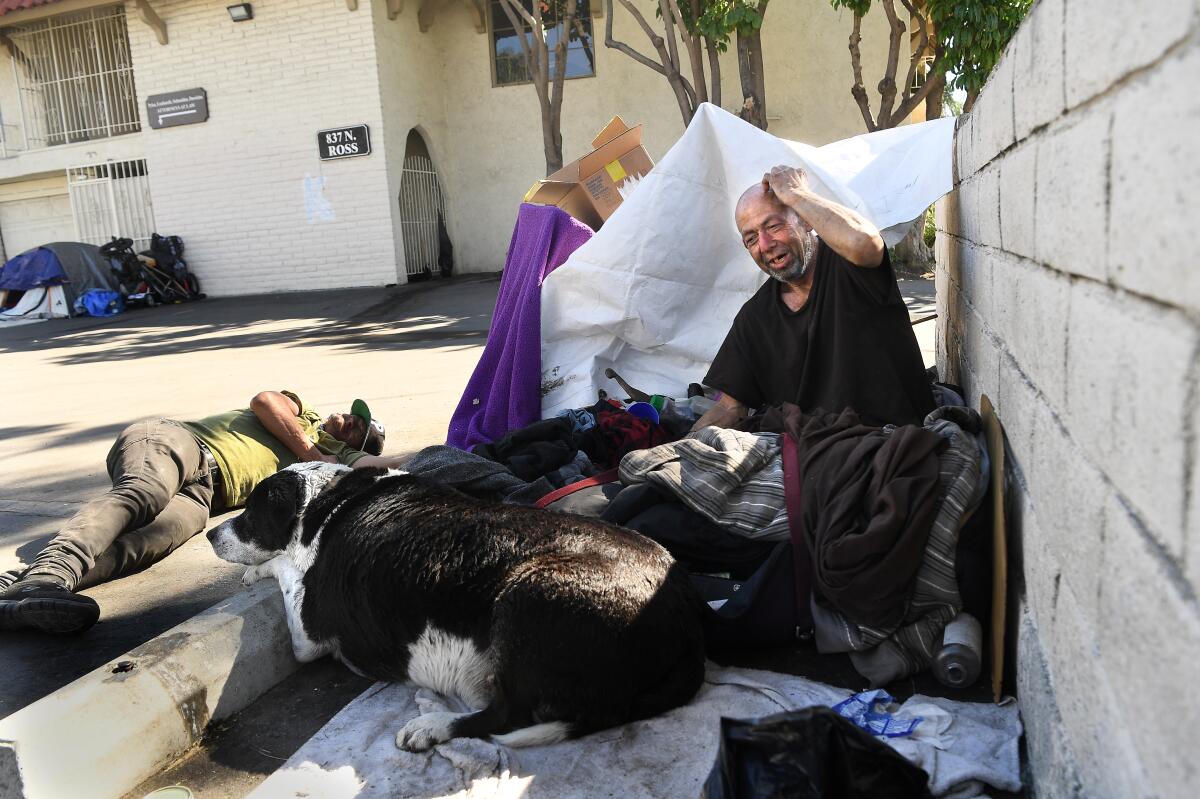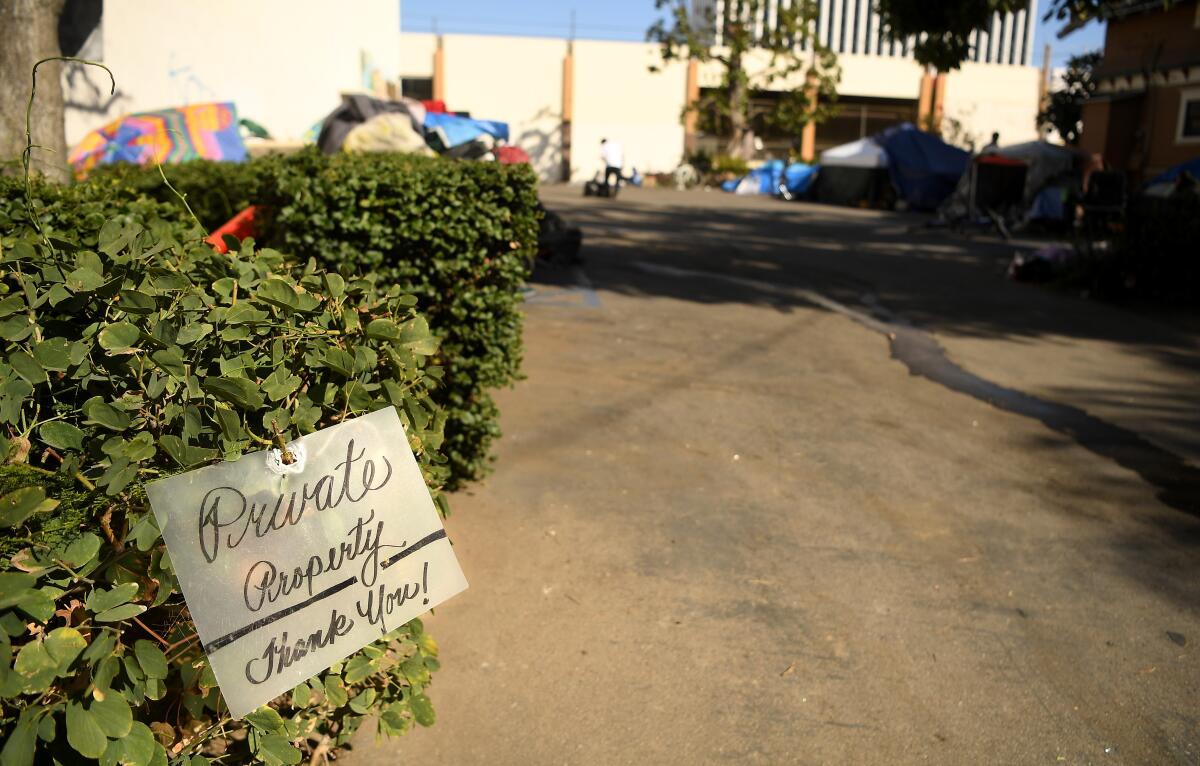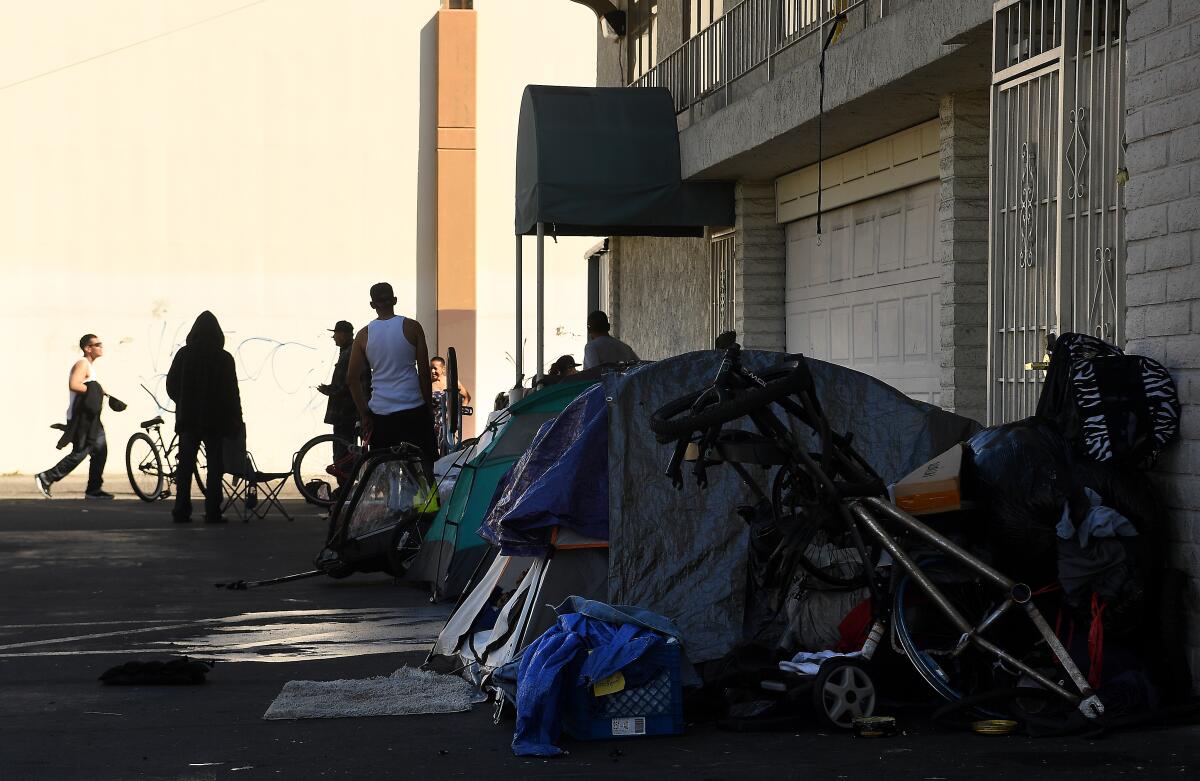A Mexican cultural center welcomed homeless people. Then came the fines

- Share via
Ben Vazquez is an optimist by nature, so the high school teacher tried to smile as he walked around El Centro Cultural de Mexico in Santa Ana last week.
He’s a longtime volunteer at the 25-year-old nonprofit, which has forged a generation of Latino activists in Orange County via a variety of classes — music, dance, language, art, even self-defense. It also holds a yearly Día de los Muertos festival that attracts over 40,000 people and is one of the largest of its kind in the United States.
The pandemic moved all of this to Zoom, so El Centro’s two-story building, within walking distance from multiple schools, no longer buzzes with kids and parents. It’s still busy, though.
Outside its walls, a homeless camp grows.

It started in March, when a few people set up sleeping bags in El Centro’s parking lot to stay the night, then leave by morning. Word spread among Orange County’s unhoused that here was a place where the property owners left folks alone. The welcome mat came from El Centro’s own history of evictions in long-gentrifying Santa Ana and the personal experience of some members with homelessness.
But you know how the maxim goes: Give someone an inch, and they’ll take the ruler and smack you with it.
At least 50 people hung out outside El Centro when I met Vazquez there. Tents whose quality ranged from ready for Yosemite to tarps strung up on PVC pipes sprawled across two parking lots that used to host community markets on weekends. People sat in front of El Centro’s garage doors and its entrance. Under a mural that proclaimed “Communidad Here to Stay,” someone blasted stoner rap and gruffly asked us to leave.

Vazquez swings by twice a week to leave trash bags and keep track of any damage. Plywood covers El Centro’s windows; a light pole was recently fixed after someone pulled out its copper wiring.
“Yeah, I mind them being here,” said Vazquez, 50. “But whatever they’re going through is worse than my feelings of them being here. This is taking us from our mission, but it’s the right thing to do.”
He and other El Centro members aren’t mad at the people who currently live on their space. They instead save their ire for an Orange County that still tries to pretend homelessness is an L.A. thing. For instance, county officials just shut down a shelter down the street, with no clear plan to move those who used it elsewhere.
“They closed it during a pandemic!” Vazquez exclaimed as he walked around the parking lot to introduce himself to El Centro’s newest temporary tenants. “When one closes down, people are going to get into neighborhoods and lawns. We’re the proof.”
El Centro’s goodwill is now costing it. Prospective tenants quickly decline once they see the scene. Code enforcement has fined the nonprofit $1,800; on Monday, the City Council talked with its lawyers about the matter during a closed-door session.
“I understand that they’re trying to be benevolent and humane,” said Santa Ana Mayor Vicente Sarmiento. “The problem now is that it’s become a dangerous condition. The complexity of homelessness is hard to tackle, let alone for a group not built for that.”
But El Centro remains steadfast. It refuses to call law enforcement to disband the camp and instead is working with homeless advocates. It gets to the core of what El Centro is, says board member Carolina Sarmiento.

“A lot of folks are confused why a Mexican cultural center is with this fight,” said the University of Wisconsin-Madison professor, who isn’t related to the Santa Ana mayor. “We’re not just a facade of Mexican culture. The question of displacement is at the heart of who we serve. It would be a contradiction to be talking about housing rights and immigrant rights and talk about not treating these folks as part of our community.”
El Centro has owned its building for three years but was a nomad before that. It moved from space to space as landlords booted the nonprofit for hosting punk shows orbecause of the group’s Zapatista politics. The experience convinced El Centro to sometimes let members who were in between housing to crash for a night or two when needed.
Housing remains an issue for its constituents: Last year, El Centro handed out $500 grants to over 700 local families.
“And almost all of them said they would use it for rent,” Carolina Sarmiento said.
So the decision to let homeless people stay came early on, as did a vow to not call law enforcement.
“Systematically, police have never been on the side of community,” Vazquez said. “Undocumented, immigrants, Mexicans: It hasn’t been a good history.”
But citations came quickly: Too much trash. Noise complaints. Allegations that homeless people were breaking into neighboring offices and cars. The city demanded El Centro build fences to keep people out, then fined the group when it said the project was too expensive.
“I know that their heart’s in the right place, but it just got out of control,” Mayor Sarmiento said. He also said El Centro shouldn’t worry too much about fines, saying that if the problem is solved, “they can get waived.”
But the city’s campaign against El Centro sparked its own criticism.
“El Centro has stood up courageously,” said Norberto Santana Jr., publisher of the Voice of OC, whose offices are in El Centro. “It’s shameful that the city and county expects this community center to do their work for them. This is the leaf-blower approach to homelessness. You blow them from one property to the other.”
“It’s upsetting,” said Rebecca Kovacs-Stein, a longtime Orange County homeless advocate who’s now assisting El Centro to try to slowly clear out the parking lot. “Suffering is here, and wounds are here. But Santa Ana would rather fine El Centro than help.”
Mayor Sarmiento said the city will offer its own homelessness task force to assist El Centro, which doesn’t mind as long as no law enforcement is used. In the meanwhile, Vazquez will continue to check in on the homeless camp, whose residents remain shocked they’re even there in the first place.
“The hospitality is greatly appreciated,” said 42-year-old Anthony Cooper. He basked in the sun while on an office chair. “Any other place, we’d get chased out.”
Cooper admitted to Vazquez he was “a little gray” on what El Centro does, “but I know you’re for the people. When you guys aren’t here, we try to keep the line.”
“Nice, thank you,” Vazquez replied. “It looks clean today.”
Ruben Cruz was nearby with his German shepherd. “All of us here gave up on the word ‘love,’” said the 40-year old, who moved to El Centro’s lot two months ago. “But people letting us stay here gives me hope that there is love out there.”
Regina Gloria Lopez, 54, drummed on the ground with the fragments of tarp poles. “We’re grateful that they leave us alone,” said the former Cypress resident. “We try to give them respect, but we sometimes don’t do as good as we should.”
On the other side of El Centro, men worked on overturned bikes while James Mundell poured water onto the asphalt and swept up trash. In front of a bush, someone had hung a sign that said “Private Property — Thank You!”
“We’re guests here,” the 40-year-old Mundell said. “So we need to keep things nice.”
More to Read
Sign up for Essential California
The most important California stories and recommendations in your inbox every morning.
You may occasionally receive promotional content from the Los Angeles Times.














